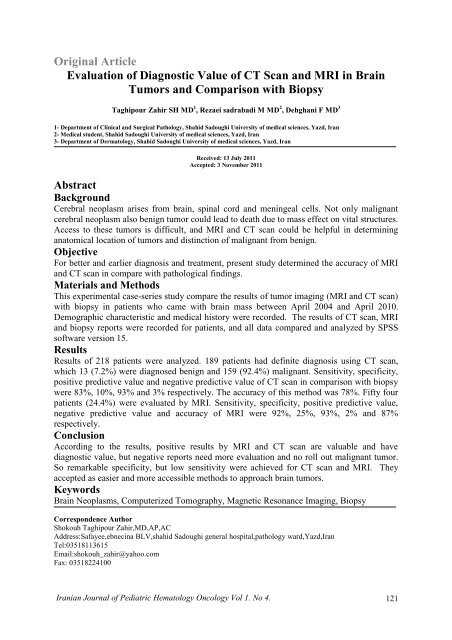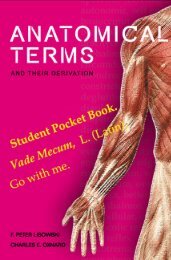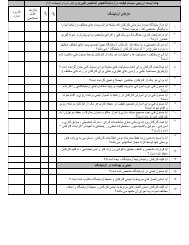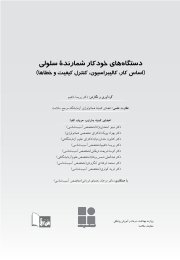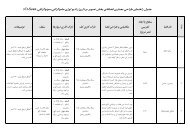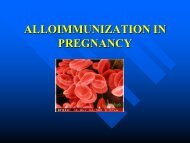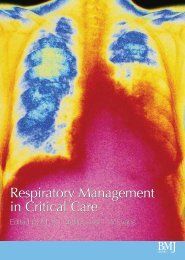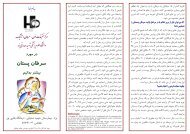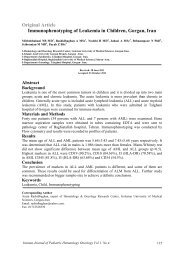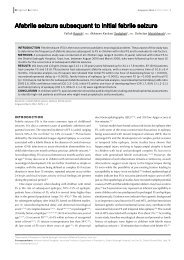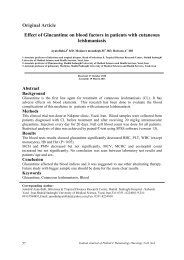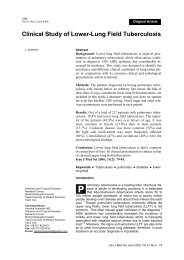Evaluation of Diagnostic Value of CT Scan and MRI in Brain Tumors ...
Evaluation of Diagnostic Value of CT Scan and MRI in Brain Tumors ...
Evaluation of Diagnostic Value of CT Scan and MRI in Brain Tumors ...
You also want an ePaper? Increase the reach of your titles
YUMPU automatically turns print PDFs into web optimized ePapers that Google loves.
cases, that 84.6% were malignant. Malignant tumors with calcification, shift<strong>in</strong>g <strong>and</strong> edemawere 94.1%, 91.3% <strong>and</strong> 95.8% respectively. Hydrocephaly was found with 21 cases by <strong>CT</strong>scan, which 76.2% were malignant <strong>and</strong> it was significant. It means that hydrocephaly maypredict malignant lesions (Table4).Glioblastoma multiform is the most frequent type <strong>of</strong> malignancy <strong>in</strong> these specimens (Table5).Table1: Frequency distribution <strong>of</strong> <strong>CT</strong> scan <strong>and</strong> biopsy reports <strong>in</strong> diagnosis malignancyBiopsy reports<strong>CT</strong> scan resultsMalignant Benign SumMalignant 148 10 158Benign 30 1 31Sum 178 11 189P-value=0.69<strong>MRI</strong> reportTable2: Frequency distribution <strong>of</strong> <strong>MRI</strong> <strong>and</strong> biopsy reports <strong>in</strong> diagnosis malignancyBiopsy reportMalignant Benign SumMalignant 46 3 49Benign 4 1 5Sum 50 4 54P-value=0.33Biopsy reportsChief compla<strong>in</strong>tsTable3: Relation between chief compla<strong>in</strong>ts <strong>and</strong> type <strong>of</strong> tumor <strong>in</strong> biopsy reportsMalignant (%) Benign (%) Sum (%) p-valueHeadache 93.1 6.9 53 0.580Seizure 100 0 22 0.044Hemi paresis 98.2 1.8 26 0.192Others 92.7 7.3 62 0.380Sum 92.4 7.2 100Table 4: Distribution frequency <strong>of</strong> biopsies f<strong>in</strong>d<strong>in</strong>gs based on <strong>CT</strong> scan criteriaBiopsy reportsMalignant (%) Benign (%) Sum (%) p-value<strong>CT</strong> scan criteriaCystic 91.7 8.3 11.1 0.641Solid 84.6 15.4 11.9 0.054Calcification 94.1 5.9 7 1Shift<strong>in</strong>g 91.3 8.7 31 0.335Edema 95.8 4.2 22 0.738Enhancement 90.7 9.3 24 0.317Hydrocephaly 76.2 23.8 9.5 0.04Iranian Journal <strong>of</strong> Pediatric Hematology Oncology Vol 1. No 4.123
Table 5: prevalence <strong>of</strong> bra<strong>in</strong> tumors based on pathological f<strong>in</strong>d<strong>in</strong>gsType <strong>of</strong> tumorPrevalenceGlioblastoma 23.9Astrocytoma 13.8Men<strong>in</strong>gioma 11.5Metastasis 10.1Ependymoma 3.2Meduloblastoma 2.8Oligodendroglioma 2.8Schwannoma 2.8Pituitary Adenoma 1.4DiscussionAccord<strong>in</strong>g to our data, <strong>CT</strong> scan <strong>and</strong> <strong>MRI</strong> were sensitive imag<strong>in</strong>g <strong>in</strong> <strong>in</strong>tra cranial tumors butthey are not specific .Their high positive predictive value <strong>and</strong> low negative predictive valuealso made them reliable diagnostic procedures when it is difficult to access mass directly. Ourdata showed also that seizure may predict malignant tumors but other symptoms likeheadache, hemi paresis, diplopia, vomit<strong>in</strong>g <strong>and</strong> nausea were not so. In this study relationbetween <strong>CT</strong> scan f<strong>in</strong>d<strong>in</strong>gs <strong>and</strong> pathologic f<strong>in</strong>d<strong>in</strong>gs surveyed <strong>and</strong> concluded that some f<strong>in</strong>d<strong>in</strong>gslike cystic or solid lesions, calcification, shift<strong>in</strong>g, edema <strong>and</strong> enhancement did not predisposebiopsy reports, but hydrocephaly found as a predictive f<strong>in</strong>d<strong>in</strong>g <strong>in</strong> <strong>CT</strong> scan reports fordeterm<strong>in</strong><strong>in</strong>g malignant tumors. Huget <strong>and</strong> et al <strong>in</strong> 1995 reported that accuracy betweenradiological diagnostics <strong>and</strong> tissue biopsies were 66 %(8) <strong>in</strong> a similar study <strong>in</strong> 2000 bySalmon for <strong>MRI</strong> reports accuracy was 63 % (9).A study <strong>in</strong> Japan from1997 to 2000 concludedthat accuracy <strong>of</strong> <strong>MRI</strong> reports for Ependymoma, Schwannoma <strong>and</strong> metastatic tumors wererespectively 100%,92.4%<strong>and</strong>82% (10.)In a study that on 52 patients 83% <strong>MRI</strong> reports hadcorrelation with biopsy (11). Some other researches designed for estimat<strong>in</strong>g sensitivity <strong>and</strong>specificity <strong>of</strong> <strong>CT</strong> scan <strong>in</strong> diagnosis bra<strong>in</strong> tumors. Miller <strong>and</strong> et.al reported these values 89%<strong>and</strong> 82% but <strong>in</strong> Italy for metastatic lesions its sensitivity <strong>and</strong> specificity were 92% <strong>and</strong> 99%(12, 13). Morano P <strong>and</strong> et.al <strong>in</strong> 1998 used the <strong>in</strong>formation <strong>of</strong> 52 patients that 48%<strong>CT</strong> scanreports were like biopsy ones (14).For <strong>MRI</strong> reports also similar studies designed. Barlonreported that accuracy between its reports <strong>and</strong> biopsy was76.1 % (3) but it was 98.7% <strong>in</strong>Sarkar A. <strong>and</strong> et.al study (15).Accord<strong>in</strong>g to these studies <strong>and</strong> our results we concluded that<strong>MRI</strong> has more accuracy than <strong>CT</strong> scan for diagnosis bra<strong>in</strong> tumors <strong>and</strong> biopsy correlation.ConclusionAccord<strong>in</strong>g to recent study bra<strong>in</strong> lesions biopsy with pathological reports have a high value <strong>in</strong>diagnosis <strong>of</strong> tumors, but sometimes that the biopsy specimens are scanty or acceptability tothe tumor is difficult or differentiation between low grade astrocytoma from gliosis isdifficult, <strong>MRI</strong> <strong>and</strong> <strong>CT</strong> scan could be very helpful for pathologists to report their diagnosis.AcknowledgmentThe authors would like to thank Dr Mansour Moghimi for his advices.Conflict <strong>of</strong> <strong>in</strong>terestNone <strong>of</strong> the authors have any conflicts <strong>of</strong> <strong>in</strong>terest to declare.124 Iranian Journal <strong>of</strong> Pediatric Hematology Oncology Vol 1. No 4.
References1. Gilman S, Imag<strong>in</strong>g the bra<strong>in</strong>, N Engl J Med 1998; 338:889-896.2. W<strong>in</strong>n Richard H. , Youmans neurological surgery,6th ED ,Philadelphia:saunders Elsevier ;2011:2988-2990.3. Gut<strong>in</strong> PH, Posner JB. Neuro-oncology: Diagnosis <strong>and</strong> management <strong>of</strong> cerebral gliomas-past, present, <strong>and</strong>future. Neurosurgery 2000; 47 (1):1-8.4. Med<strong>in</strong>a LS, P<strong>in</strong>ter JD, Zurakowski D, Davis RG, Kuban K, Barnes PD. Childrenwith headache: cl<strong>in</strong>icalpredictors <strong>of</strong> surgical space-occupy<strong>in</strong>g lesions <strong>and</strong> therole <strong>of</strong> neuroimag<strong>in</strong>g. Radiology. 1997Mar;202(3):819-24.5. Poussa<strong>in</strong>t TY, Gudas T, Barnes PD. Imag<strong>in</strong>g <strong>of</strong> neuroendocr<strong>in</strong>e disorders <strong>of</strong> childhood. Neuroimag<strong>in</strong>g Cl<strong>in</strong> NAm. 1999 Feb;9(1):157-75.6. Scott JN, Brasher PM, Sevick RJ, Rewcastle NB, Forsyth PA. How <strong>of</strong>ten arenonenhanc<strong>in</strong>g supratentorialgliomas malignant? A population study. Neurology.2002 Sep 24;59(6):947-9.7. William W, Orrison JR , neuroimag<strong>in</strong>g , philadelphia;Saunders;2000; 2:1625-1628.8. Gilles FH, Brown WD, Leviton A, Tavare CJ ,Adelman L, Rorke LB, et al , Limitations <strong>of</strong> the World HealthOrganization classification <strong>of</strong> childhood supratentorial astrocytic tumors. Children Bra<strong>in</strong> TumorConsortium.; Cancer. 2000 Mar 15;88(6):1477-83.9. Kumar ,Cotran, Robb<strong>in</strong>s ,Basic pathology,6th edition.2003:645-651.10. Mc gee J, Isacson P, Wright N. Oxford textbook <strong>of</strong> pathology. 1992;2b:1893-4.11.Massager N, David P, Goldman S, Pirotte B, Wikler D, Salmon D, et al. Comb<strong>in</strong>ed magnetic resonanceimag<strong>in</strong>g- <strong>and</strong> positron emission tomography-guided stereotactic biopsy <strong>in</strong> bra<strong>in</strong>stem mass lesions: diagnosticyield <strong>in</strong> a series <strong>of</strong> 30 patients,J Neurosurg 2000;93(6):951-7.12. Zimmerman RA. Imag<strong>in</strong>g <strong>of</strong> adult central nervous system primary malignantgliomas.Stag<strong>in</strong>g <strong>and</strong> followup.Cancer.1991;67(4 Suppl):1278-83.13.Moriarty TM ,Kik<strong>in</strong>is R, Jolesz FA, Black PM ,Alex<strong>and</strong>er E 3rd .Magnetic resonance imag<strong>in</strong>g therapy.Intraoperative MR imag<strong>in</strong>g, Neurosurg cl<strong>in</strong> N AM,1996 Apr;7(2):323-31.14.Hill DL, Hawkes DJ ,Gleeson MJ ,Cox TC ,Strong AJ ,Wong WL, et al . Accurate frameless registration <strong>of</strong>MR <strong>and</strong> <strong>CT</strong> images <strong>of</strong> the head: applications <strong>in</strong> plann<strong>in</strong>g surgery <strong>and</strong> radiation therapy, Radiology, 1994May;191(2):447-54.15. Bell D, Grant R, Collie D, Walker M , IR Whittle I.R .How well do radiologist diagnosis <strong>in</strong>tracerebraltumor histology on <strong>CT</strong>? F<strong>in</strong>d<strong>in</strong>gs from a prospective multicentric study, British journal <strong>of</strong> neurosurgery,2002 Dec ;16( 6): 573-577.16. Hagen T,Nieder C,Mor<strong>in</strong>glane JR. Feiden W,Konig J, correlation <strong>of</strong> preoperative neuroradiologic withpostoperative histological diagnosis <strong>in</strong> pathological <strong>in</strong>tracranial process. Der Radiologe, Nov 1995;35(11):808-15.17.Walker DG.,Kaye AH. Diagnosis <strong>and</strong> management <strong>of</strong> astrocytoma,oligodendroglioma <strong>and</strong> mixed gliomas ,areview ,Australasian Radiology.2001;45(4):472-482.Iranian Journal <strong>of</strong> Pediatric Hematology Oncology Vol 1. No 4.125


